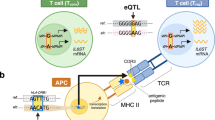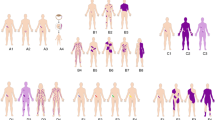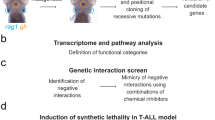Abstract
The T/t complex is an extensive genetic region proximal to the H–2 complex on mouse chromosome 17, with multiple effects on embryonic development, spermatogenesis and recombination1–3. Recently, two-dimensional gel analysis of testicular cell proteins identified a gene within the T/t complex that codes for a major cell surface-associated protein, p63/6.9 (ref. 4). The wild-type gene, Tcp-1b codes for a 63,000-motecular weight protein (p63/6.9b), whereas a mutant allele, Tcp-1a, which occurs in all intact t haplotypes, codes for a more acidic form of the protein (p63/6.9a). Analysis of partial t haplotypes obtained from rare recombination events showed that Tcp-1a correlated completely with the tail interaction factor tT, which is thought to be a genetic allele of T, thus raising the possibility that the locus of T codes for the p63/6.9 protein. We report here that the p63/6.9 proteins produced by seven chromosomes carrying independently derived dominant mutations at the locus of T are all indistinguishable from the wild-type form; thus, Ehe cumulative data indicate that the Tcp-1 gene is most probably not at the locus of T.
This is a preview of subscription content, access via your institution
Access options
Subscribe to this journal
Receive 51 print issues and online access
$199.00 per year
only $3.90 per issue
Buy this article
- Purchase on Springer Link
- Instant access to full article PDF
Prices may be subject to local taxes which are calculated during checkout
Similar content being viewed by others
References
Bennett, D. Cell 6, 441–454 (1975).
Klein, J. & Hammerberg, C. Immun. Rev. 33, 70–104 (1977).
Sherman, M. I. & Wudl, L. R. in Concepts in Mammalian Embryogenesis (ed. Sherman, M. I.) 136–234 (MIT Press, Massachusetts, 1977).
Silver, L. M., Artzt, K. & Bennett, D. Cell 17, 275–284 (1979).
Lyon, M. F., Evan, E. P., Jarvis, S. E. & Sayers, I. Nature 279, 38–42 (1979).
Edwards, Y. & Swallow, D. Nature 272, 309–310 (1978).
Dobrovolskaia-Zavadskaia, N. C. r. Séanc. Soc. Biol. 97, 114–116 (1927).
Johnson, D. R. Genetics 76, 795–805 (1974).
Erickson, R. P., Lewis, S. E. & Slusser, K. S. Nature 274, 163 (1978).
Searle, A. G. Genet. Res. 7, 86–95 (1966).
Bennett, D. et al. Genet. Res. 26, 95–108 (1975).
Romrell, L. G., Bellve, A. R. & Fawcett, D. J. Devl Biol. 49, 119–131 (1976).
O'Farrell, P. H. & O'Farrell, P. Z. Meth. Cell Biol. 16, 407–420 (1977).
Author information
Authors and Affiliations
Rights and permissions
About this article
Cite this article
Alton, A., Silver, L., Artzt, K. et al. Molecular analysis of the genetic relationship of trans interacting factors at the T/t complex. Nature 288, 368–370 (1980). https://doi.org/10.1038/288368a0
Received:
Accepted:
Issue Date:
DOI: https://doi.org/10.1038/288368a0
This article is cited by
Comments
By submitting a comment you agree to abide by our Terms and Community Guidelines. If you find something abusive or that does not comply with our terms or guidelines please flag it as inappropriate.



